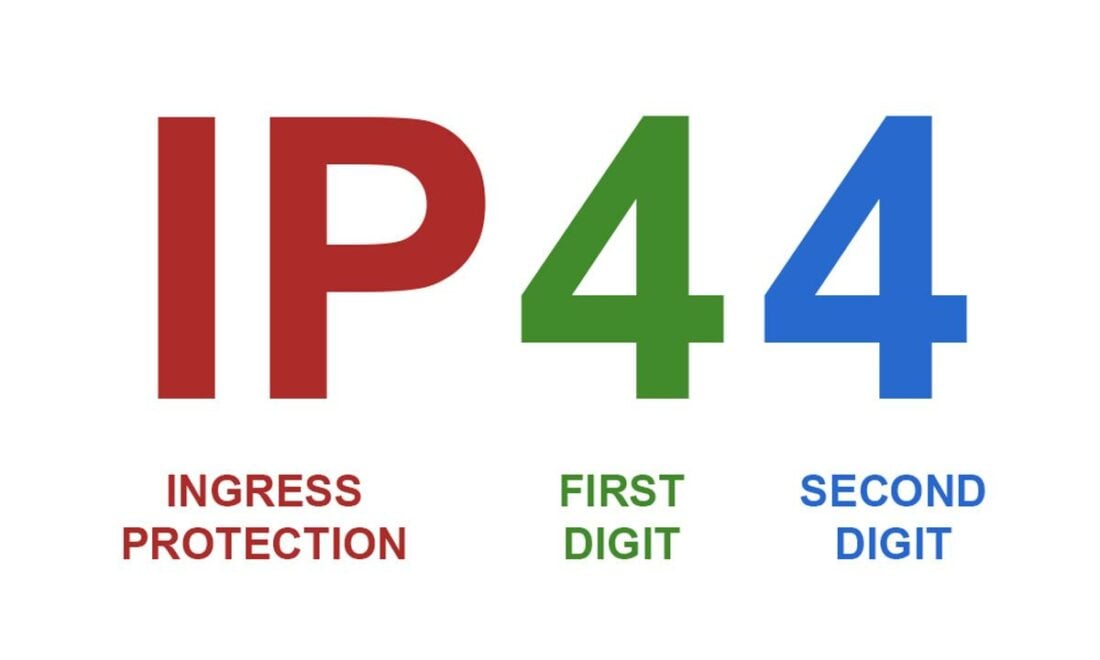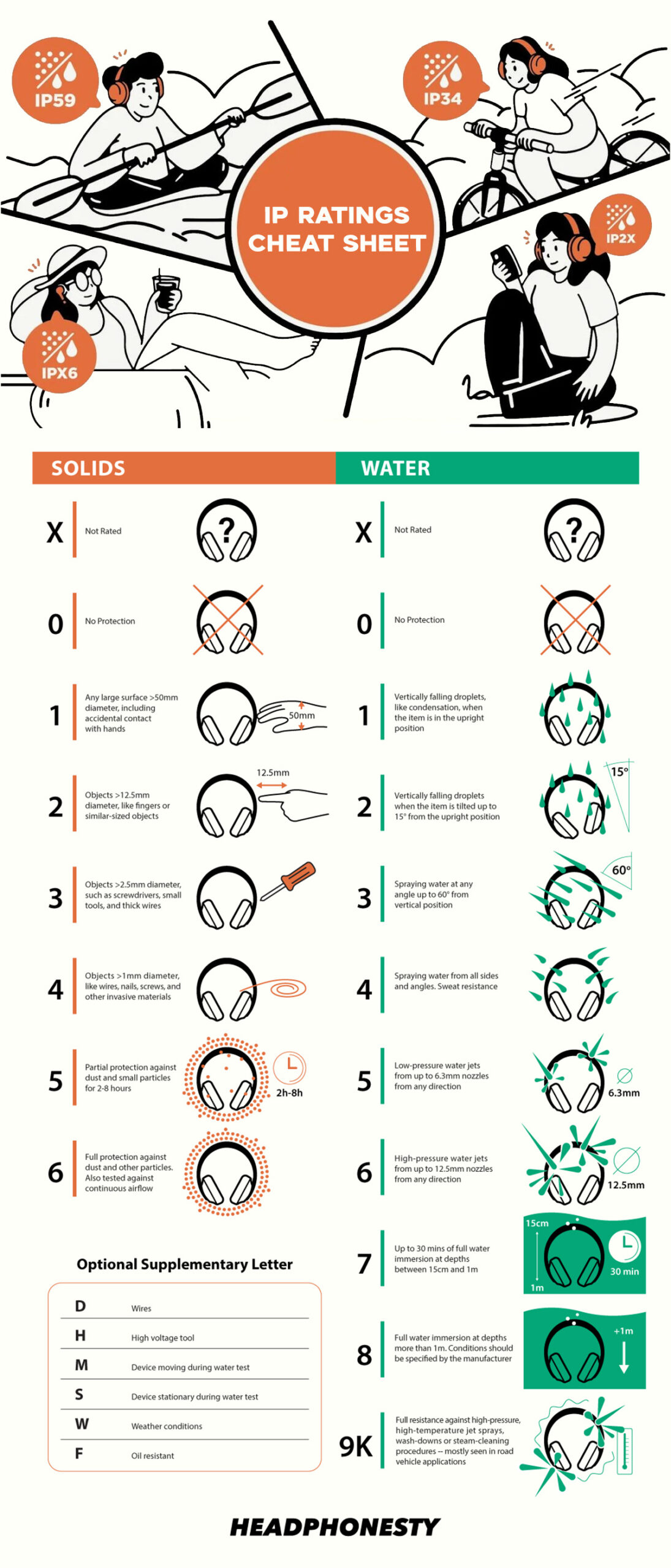For people who love watersports, working out, or any outdoor adventures, knowing the headphones’ IP ratings can be a lifesaver. With this, you’ll know your headphones’ limits and choose ones that can keep up with your activities. However, an IP rating is basically a four-character code that you need to decipher. Without the right knowledge, you can be confused and buy headphones that won’t survive your lifestyle. Understanding IP ratings is key to listening to headphones no matter where you are. Fortunately for you, we’re here to provide all there is to know about these IP ratings. Learn what they are, what they mean, and how you can utilize them below!
IP Code: Defined
The IP Code, or IP ratings as they are more commonly known, refers to the “Ingress Protection” rating. This represents the device’s level of protection against the entry of different substances. It can be found on most household devices we have bought and used, particularly our electrical and mechanical appliances. For products to be IP rated, they must be evaluated by an independent testing group. Once they’ve undergone the IEC-approved tests, only then can they display their IP ratings in their product description and marketing materials.
How to Read the IP Ratings
Unlike popular belief, the IP ratings grade three levels of protection, not just two. Its actual scope is as follows:
Protection against ingress of any of the user’s body parts, either intentional or accidental Resistance to the intrusion of dust/solid particles Resistance to penetration of moisture/water damage
An IP rating is composed of the name ‘IP,’ followed by two digits. Each digit signifies a level of protection from either solid or liquid intrusion. In some cases, a supplementary letter may be placed after the second digit.
First digit Second digit Supplementary letters
First digit
It indicates the level of protection from the intrusion of solid particles on the device/enclosures. Its degrees of protection against solid particles vary from 0 to 6. Each level indicates the solid particle size it’s effective against. As each level increases, the size of the particle also gets smaller until it’s completely dustproof (IP 6X). Additionally, the first digit also considers the protection level against any entry of the users’ body parts, e.g., fingers, portions of the skin, et al. This is more for the protection of both the device and its users than anything else.
Second digit
The second digit signifies the degree of protection from liquid penetration/water damage. Unlike the first digit, the second digit’s levels of protection range from 0 up to 9K. Each level is indicative of the amount of liquid, its direction, and the force applied to the device. Aside from that, this also includes the maximum depth and length of time the device can be submerged before it fails or shows signs of water damage.
Supplementary letters
The supplementary letters may appear after the second digit. But this is often omitted because it’s optional. Unlike these, the first and second digits are mandatory, so they must always be shown to define the IP rating at all times. Also, unlike the first two digits, different letters do not represent the levels of protection. Instead, it refers to completely different meanings. For example, F refers to whether or not the device is also resistant to oil, while M or S denotes if it’s moving while being tested under water.
The IP Ratings Cheat Sheet
Device manufacturers can proudly display their IP rating once their product has been duly IP rated. But what do their protection levels mean? Let’s check out the figure below on how each level of protection is defined:
The Truth About Weather and Waterproofing on Headphones
Whenever new electronic devices roll out, customers expect them to boast tons of features. Headphones, being consumer electronics, aren’t exempted from this. Unfortunately, some manufacturers resort to aggressive product promotions to entice as many buyers as possible. With IEC standards, any manufacturer falsely claiming that their products are “waterproof” can be answerable by law. In any court of law, statements without proof are just hearsay. In this case, it’s a baseless claim without any certified rating borders on deceptive advertising, and is a definite marketing spin. The NEMA ratings have IP rating counterparts. But unlike the IP ratings, the NEMA Ratings focuses mainly on North America, where they maintain their rating system. So, instead of relying on marketing labels, it’s best to always look for the headphones’ IP or NEMA ratings, to be safe.
Water-resistant vs. Waterproof vs. Weatherproof: The differences
‘Water-resistant’, ‘waterproof’, and ‘weatherproof’ are some vaguely used marketing terms to promote headphones. And, like buzzwords and hashtags on commercialized blogs, these terms are used to attract views and purchases. There’s a misconception that they all mean the same thing. But while they’re sometimes used interchangeably, it doesn’t make them synonymous with each other, especially when IP ratings are considered.
Water-resistant Waterproof Weatherproof
Water-resistant
Water-resistant headphones are very much capable of preventing water penetration. But only to certain degrees and circumstances. The conditions are that they can only be exposed to water in a limited capacity or be submerged at a specified depth for specific lengths of time, depending on the IP rating. For this reason, electronics manufacturers like Apple and Samsung use the term water-resistant instead of waterproof. Despite having IP-rated water-resistant products, their warranties don’t include liquid damage. For headphones to be water-resistant, their IP rating must be from IPX4 to IPX6. The Jabra Elite 85t rest comfortably in this category. They have been rated at IPX4.
Waterproof
To be waterproof is to be completely impervious to water under any conditions. These are headphones that you can safely use while doing water sports such as swimming. There are currently no established industry standards for a product to be considered waterproof in its strictest sense. But the acceptable IP ratings close to being “waterproof” for general use are those rated at IPX7 to IPX9K. However, remember that all IP rating tests were conducted in controlled lab environments. For these, they’re usually submerged only to a specified depth for specific amounts of time in freshwater instead of seawater, which has higher pH levels and smaller particles. If you’re looking for headphones to use at sea, it’s best to go for headphones with IP68 and up. Examples of these are the Shokz OpenSwim and Sony’s NW-WS413 Sports Walkman, both rated at IP68.
Weatherproof
Weatherproof products can resist damage caused by any weather conditions. These may include extreme heat, frost, excessive amounts of moisture, or even corrosion. Weatherproof products can’t be graded accurately with IP ratings since they require high resilience against weather elements. For this reason, manufacturers are encouraged to adopt alternative grading standards like the NEMA ratings.
Conclusion
By this time, we can now assume that you’ve been enlightened with what the IP Ratings are genuinely about. It’s always nice to enjoy some music with a headset that can withstand your lifestyle—all without ever worrying if they’ll get damaged or not. Maybe you’re planning to buy a new smartphone with matching earbuds. You knew beforehand what it’s capable of. You’ll get your money’s worth now. And without ever getting tricked by marketing campaigns and promotions. Did you find the article informative? Were they relatable from your side? Let us know by sharing your thoughts and dropping a comment below! We’d love to hear about your experiences with buying headphones with IP ratings in mind.

